David Roberts: Back on the Northern Frontier -Exploring the Linea Cadorna at Porto Ceresio
Continuing with last year’s researches on the North Italian Border fortifications https://www.robertspublications.com/blog/david-roberts-a-trip-to-fort-montecchio-a-fortress-on-the-italian-frontiera-nord-at-colico-lake-como , I took the opportunity of some good weather and the current absence of any lock-down to head for the charming town of Porto Ceresio on the Italian end of Lake Lugano. (Well I say the Italian end, due to the somewhat confusing nature of the border in these parts-there are actually more like two Italian ends and a Swiss middle bit of Lake Lugano, plus the isolated middle bit of Campione D ’Italia) . Porto Ceresio is an easy journey from Milan’s Porta Garibaldi railway station. Trains leave frequently, with a journey time of around 70 minutes and the round-trip fair is an eminently reasonable Euro 12. Getting the 8,32 or 9.32 trains will get you to Porto Ceresio with enough time to spend most of the day there and explore the local area. This morning, I was lucky to get one of Trenord’s Ultra-Modern, clean and airy trains which made for an easy and relaxing trip. The train wends its way rather slowly out through the suburbs of Milan, passing Rho Fiera ( the site of EXPO 2015- now looking fairly empty and forlorn ) and then up through Gallarate, Busto-Arsizio and Varese until it breaks out into the much nicer countryside of the Varesotto and you start to see the mountains close up.
As you come out of the railway station at Porto Ceresio, on a fine day there is a “wow” view, looking up the Lake towards Switzerland.
 The view coming out of Porto Ceresio Railway Station
The view coming out of Porto Ceresio Railway Station
At this point the temptation is to turn right out of the station and head towards the town of Porto Ceresio to have a coffee and relax in the sun. It is about ten minutes’ walk to get there. In fact, given the absence of any refreshments in the other direction, you may wish to partake of at least a quick coffee, before heading in the other direction to try and find the Northern Frontier (otherwise known as sistema difensivo italiano alla Frontiera Nord verso la Svizzera or more colloquially as the Linea Cadorna, after the Italian Chief of Staff, Luigi Cadorna). If you don’t need a coffee turn left out of the station and head in the opposite direction from the town and along the lake shore. For a while there is no pavement on the lake shore, so you must stay on the station side, where the footpath runs along by the end of the railway track. It is now the problems start- you need to find where the walk up to the Linea Cadorna starts. I thought I had prepared by reading an online guide in Italian ( in fact I was reading it on my phone as I walked) unfortunately the instructions were less than precise – I appreciate the effort, but if you are going to post details of walks online- at least be specific and detailed as to where they start. As you walk from the station, you will see some turnings to the left and some wooden signs – which appear to indicate a path. Ignore these siren calls, it is the wrong direction. Cross over the road junction and the small river and keep going on the left-hand side of the road along the Lake Share. You should be looking for the red and white signposts which indicate the European footpath E1. About 5 to 10 minutes from the station, you will pass a zebra crossing which leads to the lake and suddenly you will see a flight of concrete stairs to your left, with some tell-tale red and white paint marks on the steps. This is the entry to the E1.

 The hidden entrance to European Footpath E1
The hidden entrance to European Footpath E1
The E1 is one of those interesting European projects, a 7,000 km footpath running from the North Cape of Norway to Cape Passero in Sicily. Once you get up those steps, keep going and you will end up at the North Cape (maybe some years later if the signposting is not good). I will take issue with some more information in the online guide, which suggests you wear gym shoes. I suppose this is sensible advice as in “wear gym shoes and not highly polished leather loafers or Manolo Blahniks” that some people might require, I would actually suggest to wear trekking or walking boots- while the upper parts of the walk are okay, the first part is a pit of a scramble and the path is covered by a lot of loose gravel in places. You are at risk of damaging feet, ankles and expensive training shoes if you choose not to heed this advice.
After the steps have finished, you walk up a steep zigzagging path through the woods. This bit is tiring, (especially after weeks of lockdown) but is worth the perseverance. After you get into the woods proper, things start to improve and more importantly you start to find the remains of the Linea Cadorna, with carefully engineered trenches, gun emplacements and the observation galleries. At this point, we are up on a ridge looing down towards the lake and across to the Swiss side. Try and put aside the feeling that you might be better off down at the lakeside- enjoying the sun and dipping your feet in the water, rather than looking for military fortifications. And here is the strange part about this bit of the Linea Cadorna, the firing positions look down onto the lake and the Swiss were on the other side, so they would have had to boat across the lake or more likely come down the lakeside road from the Swiss frontier .
Of course, the Linea Cadorna was not really built to defend against the Swiss at all. There they were peacefully democratic, neutral and with absolutely no intention of invading their substantially larger and different to govern Southern neighbour. No, the Linea Cadorna was really built based on the hypothetical fear that the Germans might invade Italy, through Switzerland. This was a bit strange, since the Italians had been in the Triple Alliance with Germany since 1882, an alliance which was regularly renewed and updated, but is always worth hedging your bets. The Italians had already established a network of strong-points on the eastern frontier with their erstwhile enemy and current ally, Austria- Hungary and it was highly unlikely that the Austrians would invade through Switzerland – but Germany remained a concern. Most of the Italian frontier with Switzerland consisted of high mountain ranges , where the occasional passes such as Great St Bernard, Spluga and Sempione could be fortified and defended , however the area around Varese and Luke Lugano, with its much gentler hills and a border which meandered illogically around represented a weak point in Italy’s Northern defences. The Swiss canton of Ticino stretched deep down into Italian territory and any once through the Ticino Salient any invading forces faced few barriers to reaching the vital industrial heartland around Milan. From 1882 inwards, the Italian occasionally revisited projects for the Western defences and put them away again. By 1911, although the Italians remained in the Triple Alliance, they were moving closer to the British and French, and the High Command started to dust off the plans for the border fortifications again. On 18 April 1911, they started work on the section of the frontier between the Rivers Mera and Adda, particularly the gun emplacements at Fort Montecchio Nord at Colico on the North End of Lake Como. On the outbreak of World War 1, the Italians chose to stay neutral while secretly negotiating with the Triple Entente Powers to join the war on their side. On 24 May 1915, the Italians declared war on Austria- Hungary, but not on Germany. Since the Germans were continuously having to bail out the Austrians, war with Germany was a foregone conclusion and so the Italians ramped up their preparations to defend the Ticino Salient and began construction of the Linea Cadorna in earnest.
The whole project for the Northern Defence Line ran in six sectors from the Western Alps to the Eastern Alps. One sector defended the land frontier which ran from Luino on the Eastern shore of Lago Maggiore to Porto Ceresio on the western shore of Lake Lugano. Originally the defensive line was much further south, specifically defending Varese, but the Italians then began construction of defences much nearer to the frontier. The defence line consisted of artillery positions and observation points on the higher mountains, with a network of trenches, machine gun positions and mortar positions in the lower foothills and ridges above Porto Ceresio. The works were supervised by the Genio, the Italian military engineers who subcontracted the worker to local contractors in the Varese area. As well as the fortifications, a large network of military roads, mule tracks and paths were constructed to supply the defensive line. The defences were finished in 1916, by the time the Italians declared war on Germany. By mid-1917, with the Italians facing huge pressure in the East from the Austrians, who had been reinforced by German troops most of the artillery and regular army units were withdrawn from the Linea Cadorna and sent East.
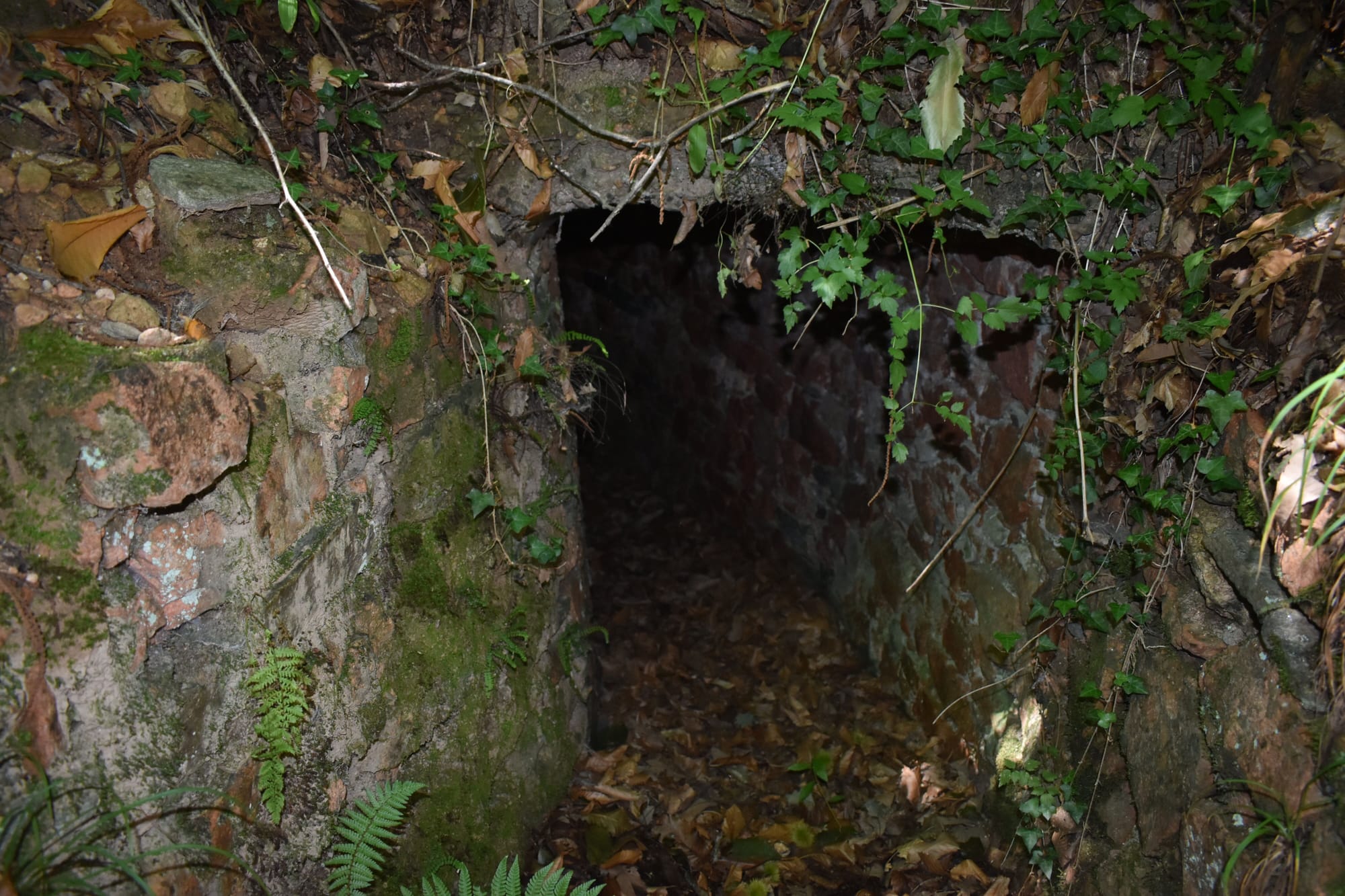 Entry to a bunker
Entry to a bunker
 A firing gallery overlooking Lake Lugano
A firing gallery overlooking Lake Lugano
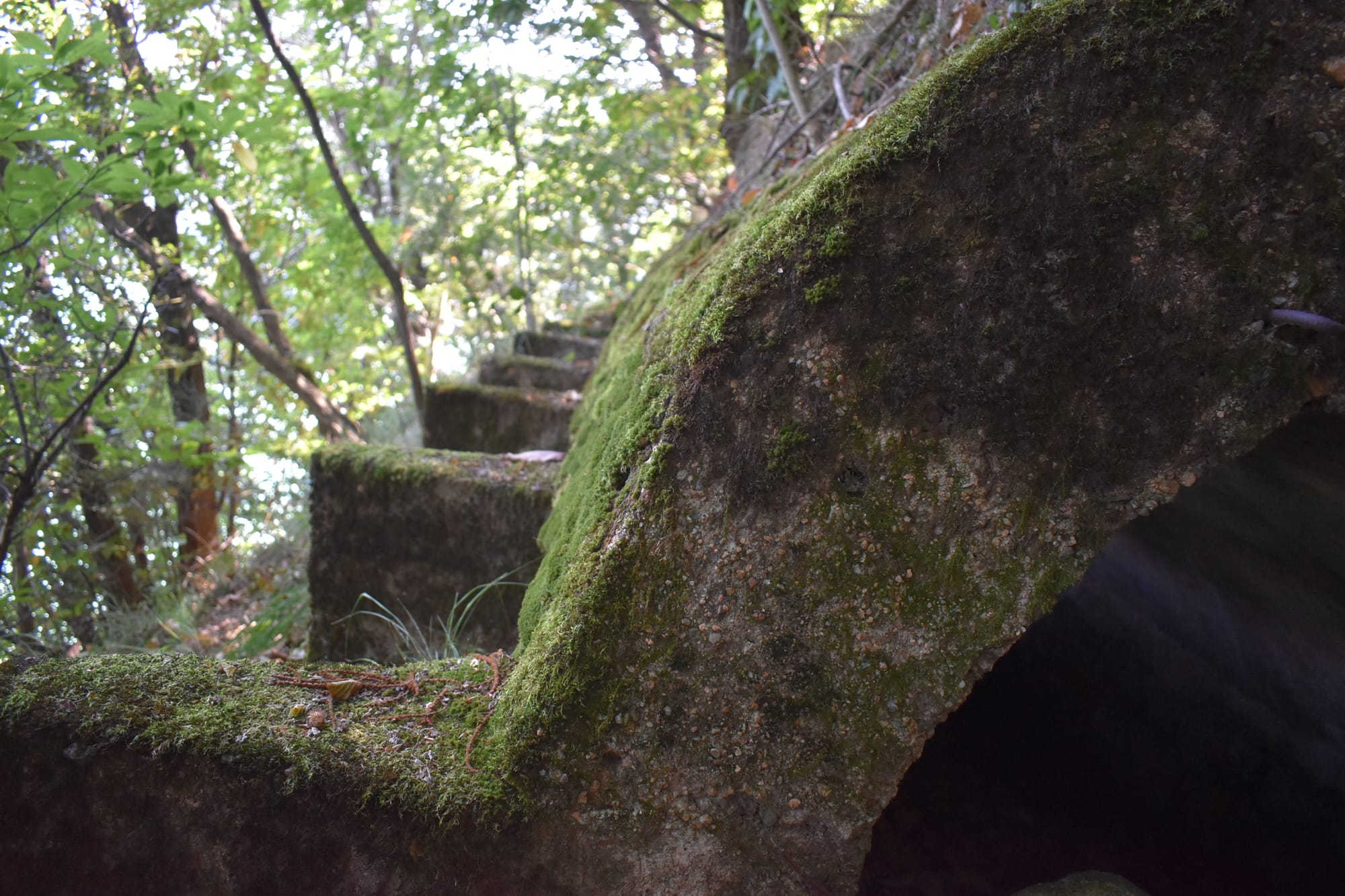 The outside of a firing gallery
The outside of a firing gallery
After a spot of admiring Italian military engineering skills, I emerge from the woods and onto the road which heads up to Borgnana. The E1 continues along the road for a while always marked by the Red/While signs and is easy to follow in this stretch. By the time I reach Borgnana, it is lunch time. Choices are limited, there are no bars or snack bars, there is however the extremely pleasant trattoria al Vecchio Faggio , where I stopped for lunch . It is actually a very good restaurant; the rest of the clientele were well- heeled looking family types out for lunch who have obviously driven there - anyway they happily accommodated me in a quiet corner. After lunch, I continue up the hill along the road to Cuasso. Here there is choice to make, you can stick with the E1 in the direction of Biochetta Stivione in a long loop which eventually takes you up and then down to the Sasso Paradiso – ( according to the guide it was estimated to take to 2 to 4 hours) , since it was now past three in the afternoon, I skipped that one and headed on the direct path to Alpe di Croce / Sasso Paradiso for some more fortifications. Again, this was quite a step uphill trek, although the path was much easier to walk on, I assume it was one of the original military roads. Sasso Paradiso is really worth the walk for a splendid view over the lake and when you get there . there are some more well-preserved firing positions and trenches looking out over the Lake. At that point you have to retrace your steps and head back to Porto Ceresio, but the good news is it downhill all the way.
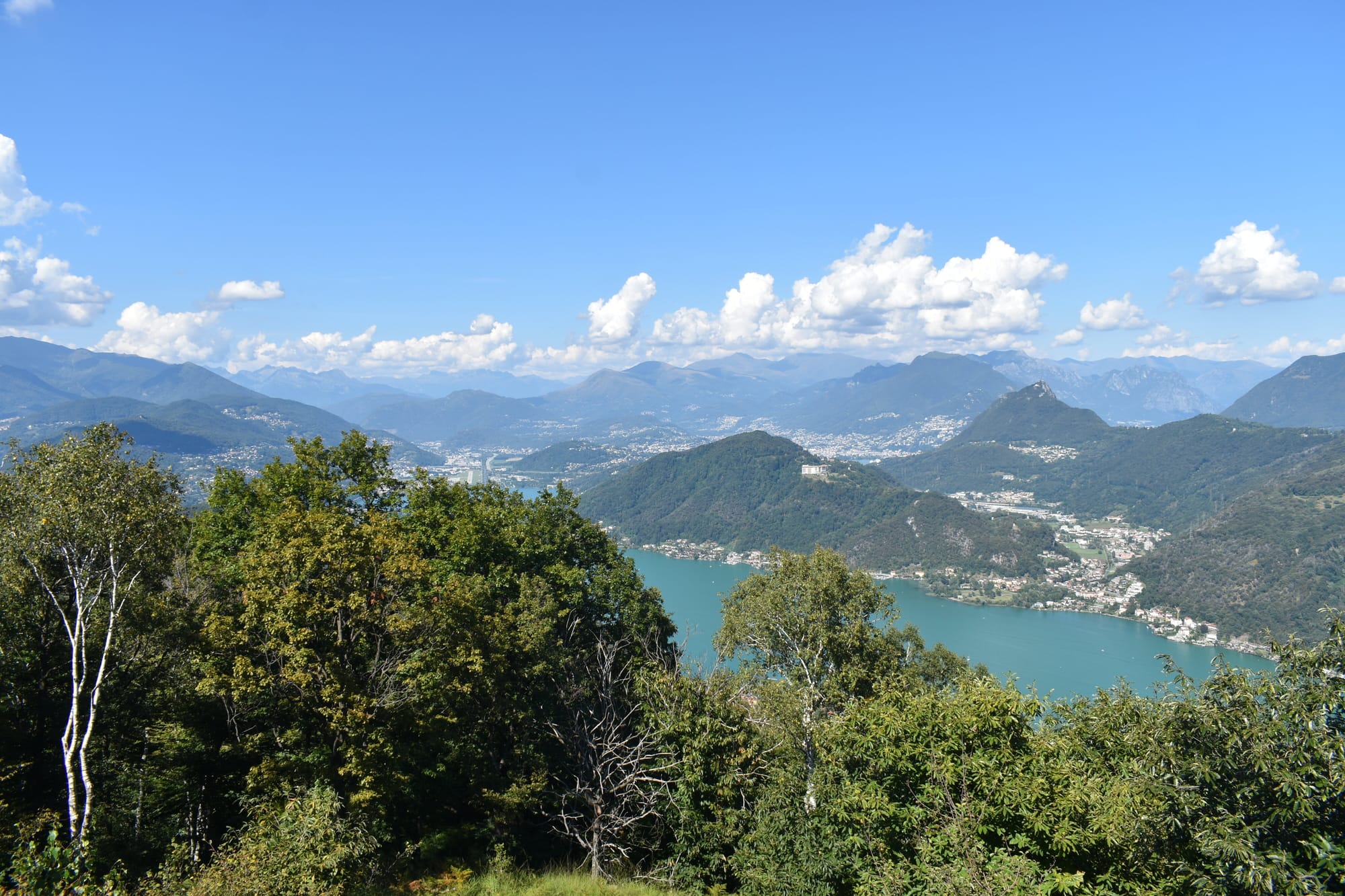 The view into Switzerland from Sasso Paradiso
The view into Switzerland from Sasso Paradiso
With any luck you get back to Porto Ceresio in time to wander into Porto Ceresio and enjoy a well-deserved Aperitivo by the Lake. Do bear in mind that there is only one train an hour back to Milan and the very last one leaves a 20.15. if you miss that you are stuck.
As well as the Aperitivo, I was on another mission. About a year ago, in Milan I has stumble across a Stolpersteine or Pietro ‘D’Inciampo, the literal translation is “stumbling stone”. They are the idea of German artist Gunter Demnig and are placed outside the place of residence or work of people who were deported during the Second World War. They are blocks of stone embedded in the pavement, with the name of the person, date of deportation and where they died. And that’s the idea, you literally stumble across the bricks in the pavement (in the sense of coming across by chance – rather than tripping. They are firmly embedded in the pavement and do not present a trip-hazard) and they remember somebody who used to live there and who ended up as a victim of Nazi-Fascist persecution. The principle being that a “person is forgotten only when their names is forgotten”. Milan has a substantial number of Stolpersteine, and I have been documenting them for a while- with the aid of a handy guide produced by the City of Milan. I think I have got to over 70 so far. The guide gives a brief biography of the persons involved and usually where they were arrested. Earlier this year, I visited the Stolpersteine for the Silvera family in via Monte Rosa and the guide said they had been arrested as they waited to cross the border into Switzerland at Porto Ceresio
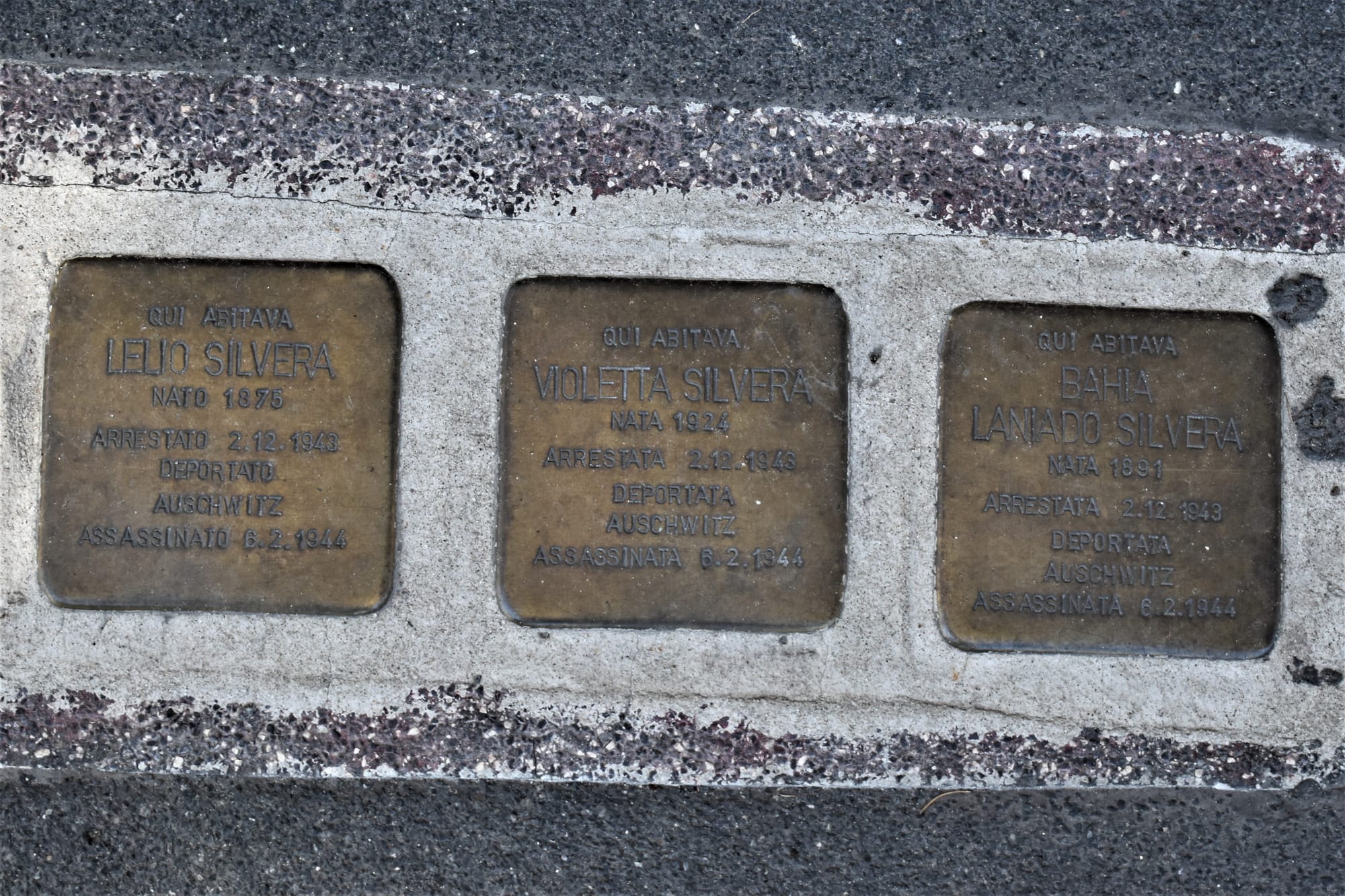 Stolpersteine for the Silvera Family, via Monte Rosa 18 Milan
Stolpersteine for the Silvera Family, via Monte Rosa 18 Milan
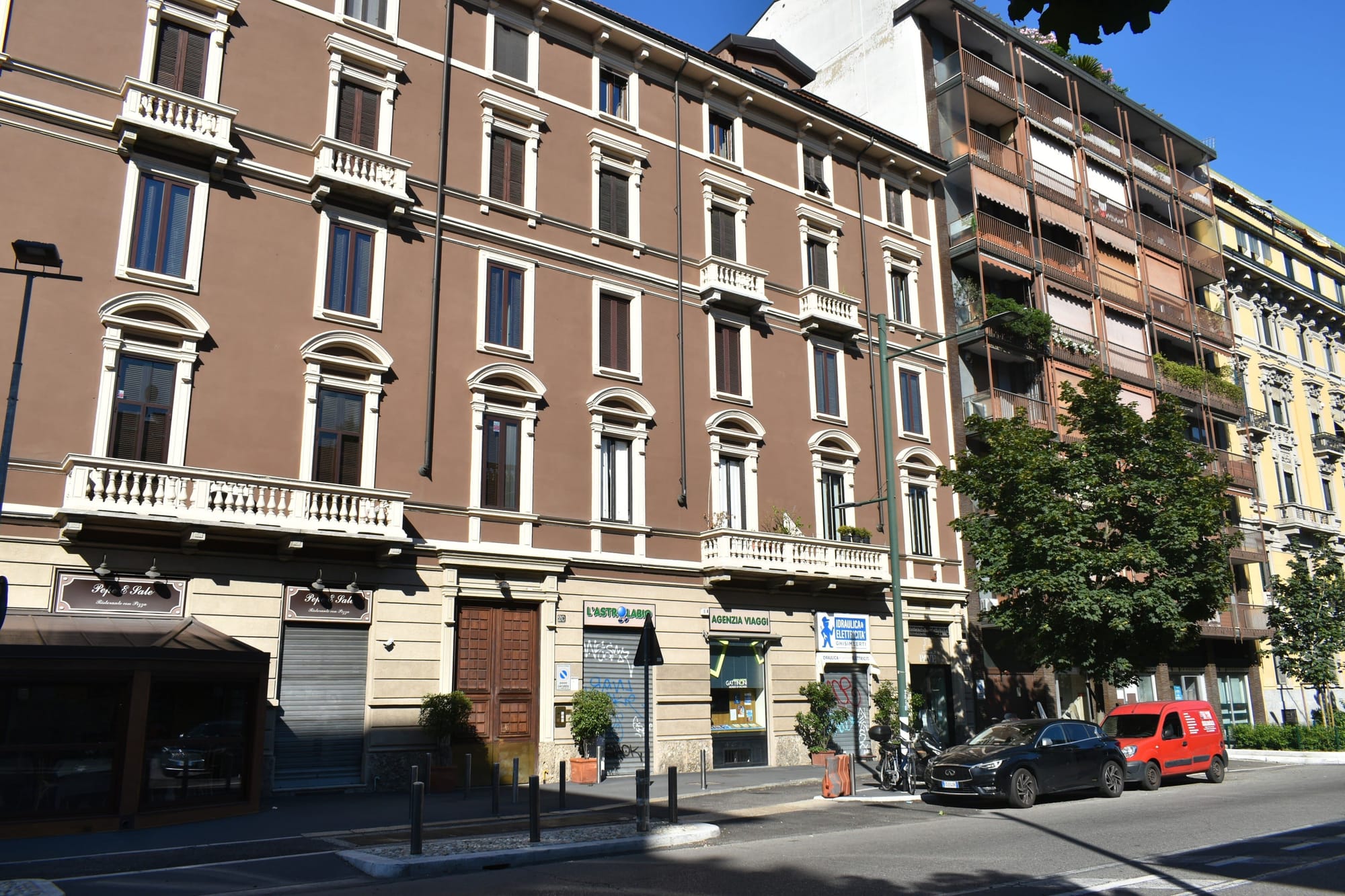 The Silvera family residence in Milan's via Monte Rosa
The Silvera family residence in Milan's via Monte Rosa
The Silveras were a Jewish family who had emigrated to Milan from Aleppo in Syria. Leilo Silvera and Bahia Laniado, were both born in Aleppo, Syria when it was part of the Ottoman Empire. Their daughter Violetta was born in Milan. Aleppo was a principal trading centre for caravans coming from the East. Italian Jewish traders, particularly from Livorno began to establish links with the city. In many cases the younger sons of Livorno based merchants were sent to Aleppo on buying trips and in some cases, they stayed there and married into local Jewish families. Following the construction of the Suez Canal, the fortunes of Aleppo as a trading centre began to decline and the rise of the Young Turks, saw many of the privileges enjoyed by the expatriate Italians withdrawn. The Jewish population began to leave Aleppo, many for the United States while the Silvera family having Italian nationality moved to Milan, where Leilo Silvera opened a textile exportation business. One of their sons Salmone went to Egypt to study, while the rest of the family stayed in Milan. In 1938, Italy enacted its own “Racial Laws” which heavily discriminated against the Jewish community, expelling them from public sector employment, schools and Italian social and civic life. Nevertheless, there were no pogroms and expulsions were limited to those who had arrived in Italy after 1 January 1919. Jewish people in private enterprise, like the Silvera family were allowed to continue their commercial activities unimpeded.
By 1943, a large Jewish population remained in Milan – possibly lulled into a false sense of security, by the fact that although they were actively discriminated against nobody was rounding then and killing them. All this changed on 8 September 1943, when the Italian Government signed an armistice with the Allies and the Germans occupied Milan and the while of Northern Italy. With the German occupiers came the whole apparatus of Nazi oppression, the SS set up shop in the Hotel Regina in Milan , and a notorious SS NCO Otto Koch was tasked with rounding up Milan’s Jewish population . At this point Milan’s Jewish population started looking for a way out and Switzerland was the only place to go. Between the Armistice on 8 September and the time when the Germans occupied and closed the frontier zone on 16 September, floods of Italian refugees had crossed the Italian border into Switzerland, including whole Italian Army units. The Swiss had behaved correctly in admitting uniformed Italian soldiers and escaping Allied POWs interning them for the duration of the war, they also continued to admit Italian political refugees – unfortunately Jewish refugees fleeing racial persecution in Italy were not guaranteed admittance and regrettably large numbers were turned back having reached Switzerland. As a result of Swiss public opinion, this policy was ultimately to change. So even getting to the Swiss border was no guarantee of freedom, but it was better than nothing. On 30 November 1943 Guido Buffarini Guidi, Minister of the Interior of the Italian Social Republic issued Ordinanza di polizia RSI n.5 to the Italian police in German-occupied northern Italy to arrest all Jews except those born of mixed marriages. The order specified the confiscation of their property and internment of all Jews except those born of mixed marriages, stipulating that the police should monitor the latter. It also specified that the arrested Jews should be held in concentration camps.
Several relief organisations helped Jewish refugees from Milan to get to the frontier, the Jewish DELASEM and the Catholic and Boy Scout based Italian organisation OSCAR being notable. Once at the frontier zone things got very complicated. By 16 September German troops had arrived in Porto Ceresio together with specialist Border guards and established a three km deep prohibited zone. There was a frontier post on the lakeside road about half an hours walk from Porto Ceresio, but it was heavily guarded . up in the hills, the border was fenced and protected by alarmed trip wires. German border police patrolled with dogs and the area supported by the Fascist Militia of the Guardia Nazionale Repubblicana. Navigation on the lake was restricted to professional fisherman, who were only allowed out between dawn and dusk. After dusk, powerful searchlights illuminated the waters of the lake. The only chances to get through the border were with the support of local people working with OSCAR and escape organisations, out of their own decency or with professional people smugglers. The convoluted nature of the border had always made it particularly attractive to smugglers- generally they would smuggle goods into Switzerland for Swiss Frances and then convert the Frances at Black Market rates in Italy, making huge financial gains. As the Germans closed the frontier, the smugglers began smuggling people instead, for extremely high fees. The best result for refugees was that they paid the smugglers a high price and got across the border, but it was not unknown for them to take the money and then betray the desperate refugees to the authorities.
I found that at Porto Ceresio, there was also an unlikely way to get across the border with the assistance of the men of Reale Guardia di Finanza (the Finance Police). Admittedly, as a sometime taxation practitioner the words Guardia di Finanza strike fear into the heart, but in 1943 the decent and honourable men of the local Finance Police, actively helped the desperate to get across the border. In fact the Reale Guardia di Finanza, was regarded with greet suspicion by the Germans and the RSI, as it was widely believed to remain loyal to the Monarchy and the Italian Royalist government in the Allied occupied South. Two Finance Police official, Domenico Amato, originally from Caserta and Tullo Centuroni, from Dolce (VR) were two men, who stepped up and did the decent thing. Unfortunately, the German border police were aware that the GdF were actively helping clandestine expatriations into Switzerland. On 17 February 1994, Domenico Amato was arrested along with a local fisherman Pietro Buzzi and a businessman Antonio Angelo Cattaneo- they were charged with “having been responsible for helping in a number of occasions individuals flee to Switzerland, including Hews and political criminals. The individuals having confessed during the interrogations to which they were subjected”. Amato died at Gusen, one of the sub-camps of the Mauthausen extermination camp on 27 February 1945. On 21 March 1944, Tullo Centuroni was also arrested by the German Border police, allegedly for allowing postal correspondence across the frontier. Although no specific record exists, he too is believed to have died at Mauthausen. On 18 June 2008, both Amato and Centuroni were posthumously awarded Italy’s Gold Medal for Civic Merit for their activities in helping Jewish refugees. The citation read “They provided an admirable example of the highest moral dignity and a generous spirit of sacrifice and human solidarity”
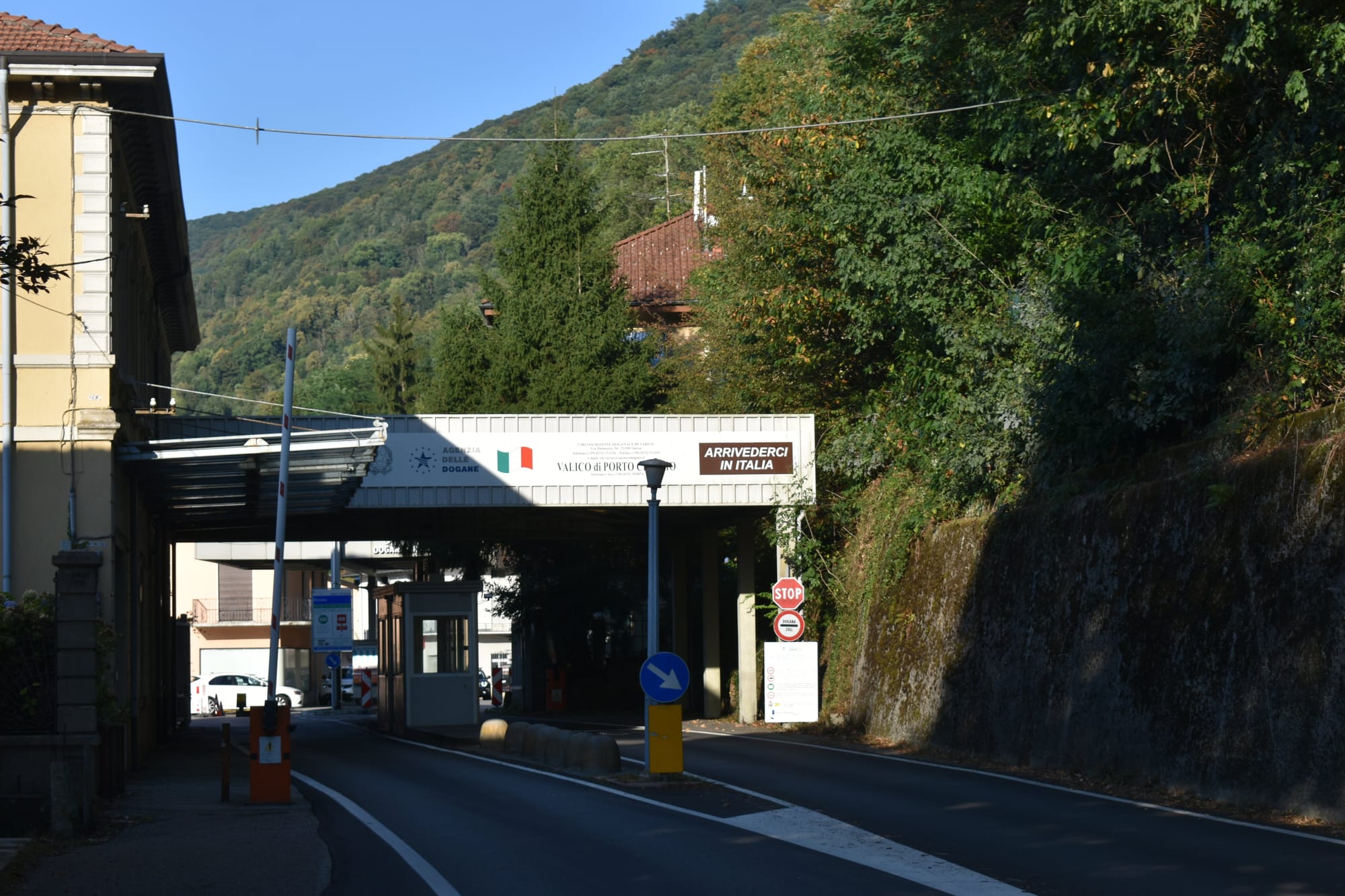 The Italian- Swiss frontier at Porto Ceresio. Today all is quiet -in 1943 it was a prohibited area
The Italian- Swiss frontier at Porto Ceresio. Today all is quiet -in 1943 it was a prohibited area
It was against this background that the whole Silvera family were arrested on 2 December 1943. We will never know how they got to Porto Ceresio or how they intended to cross the frontier, one can perhaps conjecture that the issue of Ordinanza di polizia RSI n.5 caused them to flee at that particular time. Coincidentally on the same day , the Germans also detained a number of locals and started folding up some of the more prominent escape organisation in Porto Ceresio.. It was the cruelest fate, the poor Silveras could see Switzerland, they were less than half an hour walk away, but unfortunately for them Porto Ceresio had become a trap and there was no way out. They were arrested and taken to Varese prison, from there back to Milan’s San Vittore prison and the deported on a transport from Binario 21 of Milan’s Central Station to Auschwitz. They arrived at Auschwitz n 6 February 1944 and were most probably gassed immediately on arrival.
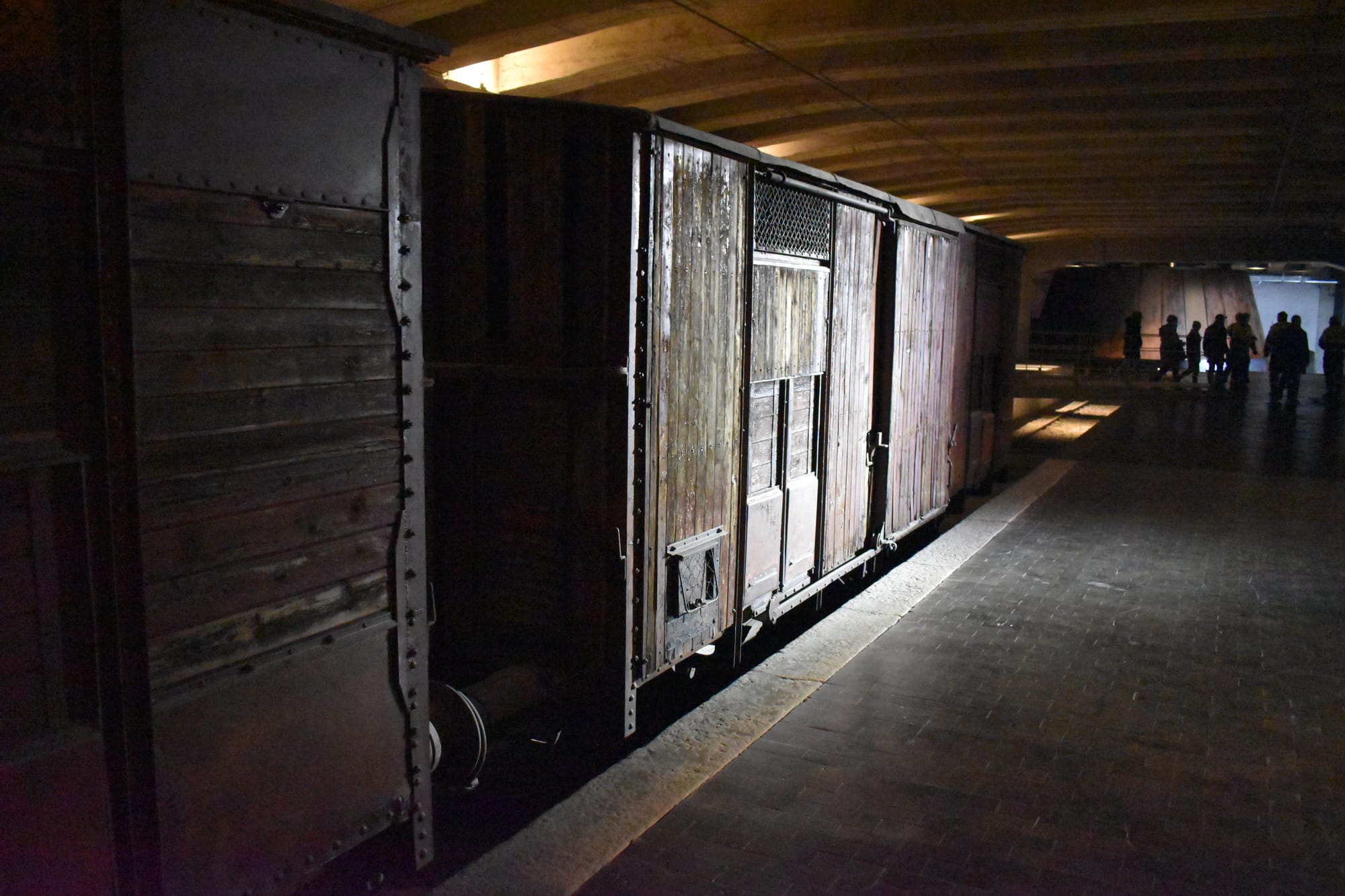 Binario 21 - the notorious underground platform at Milan Central Station used for loading deportation trains
Binario 21 - the notorious underground platform at Milan Central Station used for loading deportation trains
Having looked at the border road, I walked back into town for an Aperitivo. Fortunately, on a sunny evening in 2020, Porto Ceresio was a happy lighted hearted place. Families were still on the bathing beaches , or buying ice-creams or drinking Aperitivo’s in the central square. 77 years ago, it must have been a grim fear filled place – an armed camp surrounded by searchlights and razor wire, while German and Fascist Militias controlled the means of entry and exit. For the Silvera family, Porto Ceresio was as far as they got – they could see the prospect of freedom and the opportunity to live , but they never made it. Porto Ceresio is today a charming place and well worth a visit for a pleasant and relaxing lakeside stroll, but if you look up into the hills the woods contain trenches and fortifications for a invasion that never happened and that the border just outside the town used to represent the hope of life and freedom and the crossing it had a potentially heavy cost.
Further reading and information
More about the Linea Cadorna
http://www.provincia.va.it/lineacadorna/it/lineacadorna.htm
A very well produced site. All in Italian with 9 suggested routes in the Varese area and maps !
More on Domenico Amato and Tullo Centuroni and the Guardia di Finanza at Porto Ceresio
An interesting piece of local history – this one is all in Italian too
http://www.enricofuselli.it/documenti/amato_centurioni.pdf
More about Stolpersteine
http://www.pietredinciampo.eu/progetto/
For the Silvera family in particular
http://www.pietredinciampo.eu/portfolio/silvera/
For Binario 21 at Milan Central Station
http://www.memorialeshoah.it/visita/
To eat lunch in Borgnana
“Al Vecchio Faggio”
Train times